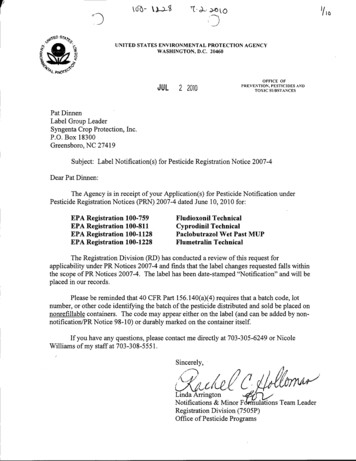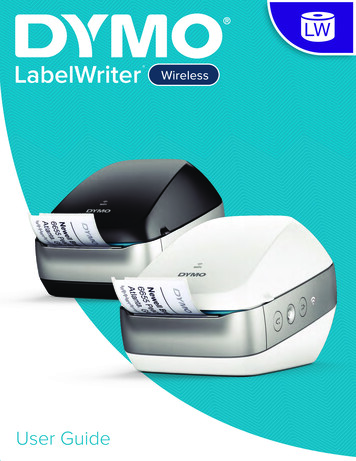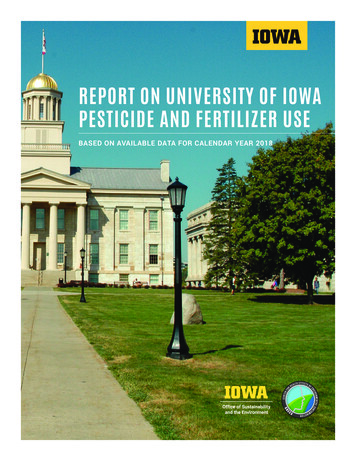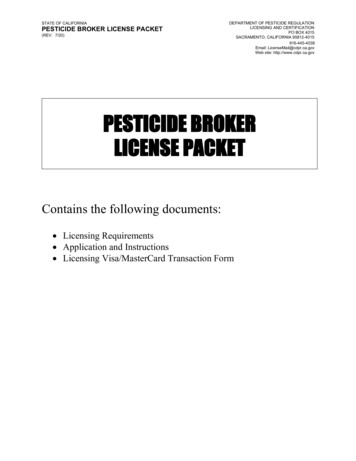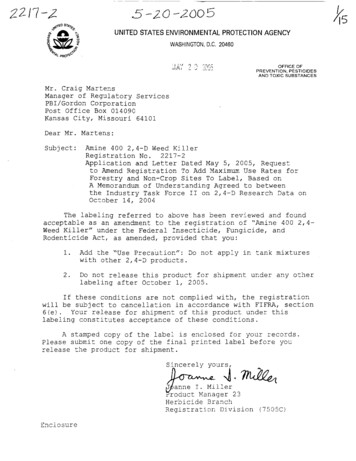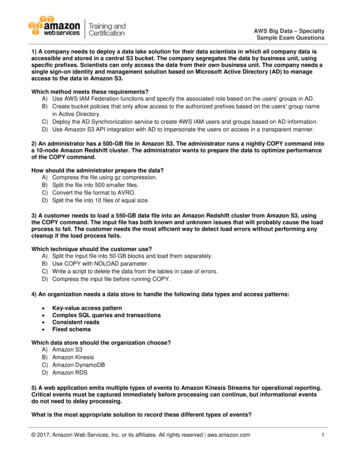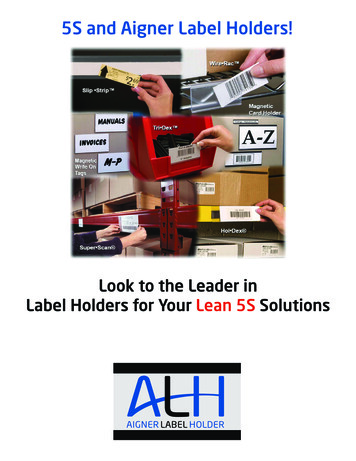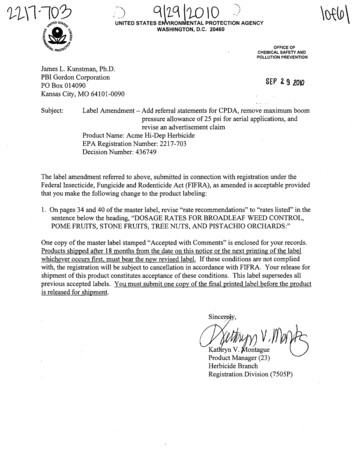
Transcription
/:)C1'lq Iw \0 )\ lo\UNITED STATES EXIRONMENTAL PROTECTION AGENCYWASHINGTON, D.C. 20460OFFICE OFCHEMICAL SAFETY ANDPOLLUTION PREVENTIONJames L. Kunstman, Ph.D.PBI Gordori CorporationPO Box 014090Kansas City, MO 64101-0090Subject:SEP 2. 9 2010Label Amendment - Add referral statements for CPDA, remove maximum boompressure allowance of 25 psi for aerial applications, andrevise an advertisement claimProduct Name: Acme Hi-Dep HerbicideEP A Registration Number: 2217-703Decision Number: 436749The label amendment referred to above, submitted in connection with registration under theFederal Insecticide, Fungicide and Rodenticide Act (FIFRA), as amended is acceptable providedthat you make the following change to the product labeling:1. On pages 34 and 40 of the master label, revise "rate- recommendations" to "rates listed" in thesentence below the heading, "DOSAGE RATES FOR BROADLEAF WEED CONTROL,POME FRUITS, STONE FRUITS, TREE NUTS, AND PISTACHIO ORCHARDS:"One copy of the master label stamped "Accepted with Comments" is enclosed for your records.Products shipped after 18 months from the date on this notice or the next printing ofthe labelwhichever occurs first, must bear the new revised label. If these conditions are not compliedwith, the registration will be subject to cancellation in accordance with FIFRA. Your release forshipment of this product constitutes acceptance of these conditions. This label supersedes allprevious accepted labels. You must submit one copy of the final printed label before the productis released for shipment.- v ··I!Kat n V. ontagueProduct Manager (23)Herbicide BranchRegistration Division (7505P)I
I'ACCEPTEDwith COMMENTS.1o\lo\In EfA.Lett!lr Dated:t l: P Z 20'{)ACME HI-DEP HERBICIDEUnder the Federal In' dicide,Fungicide, and RodeilllcideActas amended, for the pesticideregistered under EPA Reg. No.EPA Reg. No. 2217-703Six sublabels represent the entire or master label of Acme Hi-Dep Herbicide. Please refer to theappropriate section of the labeling as shown as follows:SectionLabel language common to all sublabelsSublabel1. Hi-Dep Broadleaf Herbicide, Gordon's Agricultural ProductsSublabel2. Hi-Dep CA Broadleaf Herbicide, Gordon's Agricultural ProductsSublabel3. Gordon's Orchard Master Broadleaf HerbicideSublabel4. Gordon's Orchard Master CA Broadleaf HerbicideSublabel5. Hi-Dep IVM Broadleaf HerbicideSublabel6. Gordon's Pasture Pro HerbicideAppendixDocument Control Information):. ) l ",,))). .J,J JJ.j).J ' )" ] pbl/GORc:Jon[. -.J- CORpoRationAn Employc.' .--owncd Company ; 1.2 7s ! t641011 of 60002217 -00703.201 00609.notif-proposed-highlighted.docJ
lo\Label Language Common To All SublabelsACME HI-DEP HERBICIDEEPA Reg. No. 2217-703ACTIVE INGREDIENT:Dimethylamine salt of 2,4-dichlorophenoxyacetic acid . .Diethanolamine salt of 2,4-dichlorophenoxyacetic acid . .INERT INGREDIENTS: .TOTAL .33.2%16.3%50.5%100.0%THIS PRODUCT CONTAINS:3.8 Ib 2,4-dichlorophenoxyacetic acid equivalent per gallon or 38.6%Isomer Specific By AOAC Methods.KEEP OUT OF REACH OF CHILDRENDANGER - PELIGROSi Usted no entiende la etiqueta, busque a alguien para que se la explique a Usted en detalle. (If you donot understand the label, find some one to explain it to you in detail.)KEEP FROM FREEZINGSTOP! READ THE ENTIRE LABEL FIRST. OBSERVE ALL PRECAUTIONS AND FOLLOWDIRECTIONS CAREFULLY.PRECAUTIONARY STATEMENTSHazards To Humans And Domestic AnimalsDANGER: Corrosive. Causes irreversible eye damage. Harmful if swallowed. Harmful if absorbedthrough skin. Harmful if inhaled. Do not get in eyes or on clothing. Avoid contact with skin. Avoidbreathing spray mist or vapor.Personal Protective Equipment (PPE)Some materials that are chemical-resistant to this product are natural rubber, natural rubber blends andlaminates. If you want more options, follow the instructions for category A on an EPA chemicalresistance category selection chart.All mixers, loaders, applicators, flaggers, and other handlers must wear: protective eyewear, long-sleeved shirt and long pants, shoes and socks, chemical-resistant gloves when applying with any handheld nozzle or equipment, mixing or loading,cleaning up spills or equipment, or otherwise exposed to the sed-highlighted.doc
chemical-resistant apron when mixing or loading, cleaning up spills or equipment, or otherwiseexposed to the concentrate.See engineering controls for additional requirements.User Safety RequirementsFollow manufacturer's instructions for cleaning/maintaining PPE. If no such instructions for washableseXi,st, use detergent and hot water. Keep and wash PPE separately from other laUndry 't d L Y!iw.-Cs1:obit:'WIlo\oal Engineering Control StatementsEngineering Controls for aerial applicaiton: When handlers use enclosed cabs or aircraft in a mannerthat meets the requirements listed in the Worker Protection Standard (WPS) for agricultural pesticides [40CFR 170.240(d)(4-6)], the handler PPE requirements may be reduced or modified as specified in theWPS. Pilots must use an enclosed cockpit that meets the requirements listed in the WPS for agriculturalpesticides [40 CFR 170.240(d)(6)].User Safety Recommendations Users should wash hands before eating, drinking, chewing gum, using tobacco, or using the toilet. Users should remove clothing/PPE immediately if pesticide gets inside. Then wash thoroughly andput on clean clothing. If pesticide gets on skin, wash immediately with soap and water. Users should remove PPE immediately after handling this product. Wash the outside of glovesbefore removing. As soon as possible, wash thoroughly and change into clean clothing.First AidIf in eyes: Hold eye open and rinse slowly and gently with water for 15 - 20 minutes.Remove contact lenses, if present, after the first 5 minutes, then continue rinsingeye. Call a poison control center or doctor for treatment advice.If on skin orclothing: Take off contaminated clothing. Rinse skin immediately with plenty of water for 15 - 20 minutes. Call a poison control center or doctor for treatment advice.If swallowed: If inhaled: Move person to fresh air. If person is not breathing, call 911 or an ambulance, then give artificial respiration,preferably mouth-to-mouth if possible. Call a poison control center or doctor for treatment advice.Call a poison control center or doctor immediately for treatment advice.Have person sip a glass of water if able to swallow.Do not induce vomiting unless told to by a poison control center or doctor.Do not give anything by mouth to an unconscious person.Have the product container or label with you when calling a poison control center or doctor or going fortreatment. You may also contact 1-877-800-5556 for emergency medical treatment advice.NOTE TO PHYSICIAN: Probable mucosal damage may contraindicate the use of gastric lavage.Environment JHazardsThis pesticide toxic to fish and aquatic invertebrates. Do not apply directly to water, to areaswhere surface water is present, or to intertidal areas below the mean high water mark. Drift and runoffmay be hazardous to aquatic organisms in water adjacent to treated areas. Do not contaminate waterwhen disposing of equipment wash waters or highlighted.doc
\). J. This chemical has properties and characteristics associated with chemicals detected in groundwater.The use of this chemical in areas where soils are permeable, particularly where the water table isshallow, may result in groundwater contamination. Application around a cistern or well may result incontamination of drinking water or groundwater.DIRECTIONS FOR USESTORAGE AND DISPOSALDo not contaminate water, food, or feed by storage or disposal.PESTICIDE STORAGE: Store in original container in a locked storage area inaccessible to children orpets. Keep from freezing.PESTICIDE DISPOSAL: Pesticide wastes are acutely hazardous. Improper disposal of excesspesticide, spray mixture, or rinsate is a violation of Federal law. If these wastes cannot be disposed ofby use according to label instructions, contact your State Pesticide or Environmental Control Agency,or the Hazardous Waste Representative at the nearest EPA Regional Office for guidance.[For Plastic Containers - Nonrefillable with capacities equal to or less than 5 gallons:]CONTAINER HANDLING: Nonrefillable container. Do not reuse or refill this container. Offer forrecycling, if available, or puncture and dispose of in a sanitary landfill, or by incineration, or, ifallowed by state and local authorities, by burning. If burned, stay out of smoke.Triple rinse [or pressure rinse] container (or equivalent) promptly after emptying.Triple rinse as follows: Empty the remaining contents into application equipment or a mix tank anddrain for 10 seconds after the flow begins to drip. Fill the container 1/4 full with water and recap.Shake for 10 seconds. Pour rinsate into application equipment or a mix tank or store rinsate forlater use or disposal. Drain for 10 seconds after the flow begins to drip. Repeat this procedure twomore times.[ORPressure rinse as follows: Empty the remaining contents into application equipment or a mix tankand continue to drain for 10 seconds after the flow begins to drip. Hold container upside down overapplication equipment or mix tank or collect rinsate for later use or disposal. Insert pressure rinsingnozzle in the side of the container, and rinse at about 40 PSI for at least 30 seconds. Drain for 10seconds after the flow begins to drip.][For Plastic Containers - Nonrefillable with capacities greater than 5 gallons:]CONTAINER HANDLING: Nonrefillable container. Do not reuse or refill this container. Offer forrecycling, if available, or puncture and dispose of in a sanitary landfill, or by incineration, or, ifallowed by state and local authorities, by burning. If burned, stay out of smoke.Triple rinse [or pressure rinse] container (or equivalent) promptly after emptying.Triple rinse as follows: Empty the remaining contents into application equipment or a mix tank. Fillthe container 1/4 full with water. Replace and tighten closures. Tip container on its side and roll itback and forth, ensuring at least one complete revolution, for 30 seconds. Stand the container on itsend and tip it back and forth several times. Turn the container over onto its other end and tip it backand forth several times. Empty the rinsate into application equipment or a mix tank or store rinsatefor later use or disposal. Repeat this procedure two more times.40f60002217 -00703.201 00609.notif-proposed-highlighted.doc
J[ORPressure rinse as follows: Empty the remaining contents into application equipment or a mix tankand continue to drain for 10 seconds after the flow begins to drip. Hold container upside down overapplication equipment or mix tank or collect rinsate for later use or disposal. Insert pressure rinsingnozzle in the side of the container, and rinse at about 40 PSI for at least 30 seconds. Drain for 10seconds after the flow begins to drip.][For Refillable Containers:]CONTAINER HANDLING: Refillable container. Refill this container with pesticide only. Do notreuse this container for any other purpose.Container cleaning: Cleaning the container before final disposal is the responsibility of the persondisposing of the container. Cleaning before refilling is the responsibility of the refiller.To clean the container before final disposal, empty the remaining contents from this container intoapplication equipment or a mix tank. Fill the container about 10 percent full with water. Agitatevigorously or recirculate water with the pump for 2 minutes. Pour or pump rinsate into applicationequipment or rinsate collection system. Repeat this rinsing procedure two more times.LIMITED WARRANTY AND DISCLAIMERIMPORTANT: Read this LIMITED WARRANTY AND DISCLAIMER before buying or using this product.By opening and using this product, buyer and all users agree to accept the terrns of this LIMITEDWARRANTY AND DISCLAIMER in their entirety and without exception. If the terms are not acceptable,return this product unopened immediately to the point of purchase, and the purchase price will berefunded in full.It is impossible to eliminate all risks inherently associated with use of this product. Damage to the treatedarticle, ineffectiveness, or other unintended consequences can result from use of the product underabnormal conditions such as weather, presence of other materials, or the manner or use of application,etc. Such factors and conditions are beyond the control of the manufacturer, and BY PURCHASINGAND USING THIS PRODUCT THE BUYER AND ALL USERS OF THIS PRODUCT AGREE TOACCEPT ALL SUCH RISKS. Buyer and all users further agree to assume all risks of loss or damagefrom the use of the product in any manner that is not explicitly set forth in or that is inconsistent with labelinstructions, warnings and cautions.The manufacturer warrants only that this product conforms to the chemical description given on the label,and that the product is reasonably suited for the labeled use when applied according to the Directions forUse, subject to the inherent risks described below. TO THE EXTENT CONSISTENT WITHAPPLICABLE LAW, THE MANUFACTURER NEITHER MAKES NOR INTENDS ANY OTHEREXPRESS OR IMPLIED WARRANTIES, INCLUDING ANY WARRANTY OF MERCHANTABILITY ORFITNESS FOR A PARTICULAR PURPOSE, WHICH ARE HEREBY EXPRESSLY DISCLAIMED.THE EXCLUSIVE REMEDY OF BUYER AND ALL USERS OF THIS PRODUCT, AND THE EXCLUSIVELIABILITY OF THE MANUFACTURER, FOR ANY AND ALL LOSES, DAMAGES, OR INJURIESRESULTING FROM THE USE OF HANDLING OF THIS PRODUCT, WHETHER OR NOT BASED INCONTRACT, NEGLIGENCE, STRICT LIABILITY IN TORT OR OTHERWISE, SHALL BE LIMITED, ATTHE MANUFACTURER'S OPTION, TO REPLACEMENT OR THE REPAYMENT OF THE PURCHASEPRICE FOR THE QUANTITY OF PRODUCT WITH RESPECT TO WHICH DAMAGES ARE CLAIMED.TO· THE EXTENT CONSISTENT WITH APPLICABLE LAW, IN NO CASE SHALL THEMANUFACTURER BE LIABLE FOR INCIDENTAL, CONSEQUENTIAL, OR SPECIAL DAMAGESRESULTING FROM THE USE OR HANDLING OF THE PRODUCT. The Manufacturer must be50f60002217 -00703.201 00609.notif-proposed-highlighted.doc
promptly notified in writing of any claims, whether based in contract, tort, negligence, strict liability, orotherwise, to be eligible to receive either remedy stated above.The terms of this LIMITED WARRANTY AND DISCLAIMER cannot be varied by any written or verbalstatements or agreements at the point of sale or elsewhere. No employee or agent of the manufactureror seller is authorized to vary or exceed the terms of this LIMITED WARRANTY AND DISCLAIMER inany ighlighted.doc
)SUBLABEL1Hi-Dep Broadleaf Herbicide,Gordon's Agricultural ProductsDIRECTIONS FOR USEIt is a violation of Federal law to use this product in a manner inconsistent with its labeling.Do not apply this product in a way that will contact workers or other persons, either directly or throughdrift. Only protected handlers may be in the area during application. For any requirements specific toyour State or Tribe, consult the agency responsible for pesticide regulation.Agricultural Use RequirementsUse this product only in accordance with its labeling and with the Worker Protection Standard, 40 CFRpart 170.This standard contains requirements for the protection of agricultural workers on farms, forests,nurseries, and greenhouses, and handlers of agricultural pesticides. It contains requirements fortraining, decontamination, notification, and emergency assistance. It also contains specific instructionsand exceptions pertaining to the statements on this label about personal protective equipment andrestricted-entry interval. The requirements in this box only apply to uses of this product that arecovered by the Worker Protection Standard. Do not enter or allow worker entry into treated areasduring the restricted-entry interval (REI) of 48 hours.PPE required for early entry to treated areas that is permitted under the Worker Protection Standardand that involves contact with anything that has been treated, such as plants, soil, or water is: coveralls, chemical-resistant gloves made of any water-proof material, shoes plus socks and protective eyewearNon-Agricultural Use RequirementsThe requirements in this box apply to uses of this product that are NOT within the scope of the WorkerProtection Standard for agricultural pesticides (40 CFR Part 170). The WPS applies when this productis used to produce agricultural plants on farms, forests, nurseries, or greenhouses.Reentry Statement: Do not enter or allow people (or pets) to enter the treated area until sprays havedried.f.:.Use InstructionsHi-Dep consists of the dimethylamine and diethanolamine salts of 2,4-0 especially formulated for lowvolume applications with aerial and ground equipment. This product must be applied in compliance withthe pesticide regulations of the state in which application is made. Check with local authorities regardingregulations which may affect the application of this product.AERIAL APPLICATION: Use spray volumes equal to or greater than 2 gallon per acre. This minimumspray volume is a requirement of the 2,4-0 Reregistration Eligibility Decision (RED). Spray volume at thisminimum provide more effective weed control and better highlighted.doc
AIRCRAFT SPECIFICATIONS (FIXED WING OR ROTARY WING):Number of nozzles required to obtain desired volume per acre is dependent on swath widthand speed of aircraft. Nozzles should be positioned between 135 0 and 175 0 from direction of flight forfixed wing. DO NOT APPLY THROUGH BEeO-MIST NOZZLE SYSTEMS. See manufacturer'stechnical bulletin regarding nozzles and application specifications.GROUND APPLICATION: Apply in water, 2 to 10 gallons total solution per acre with conventionalequipment. Low"dmJvlolmulmlelsm;t 0.5Im.1I1better economy. rovide more effective weed control andtlPRECAUTION FOR PAINTS AND COATINGS OF AUTOMOBILES AND OTHER VEHICLES:Undiluted spray droplets may damage the paint, coating, or finish of vehicles. Vehicles should not besprayed. If accidental exposure does occur, then the vehicle should be washed before the spray dropletsdry.WEEDS CONTROLLEDUse Hi-Dep to control many broad leaf weeds including:PERENNIAL WEEDSArtichokeDandelionLeafy spurgeAsterDockLocoweedAustrian ackeyed susanGoldenrodOrange hawkweedBlue lettuceGround ivyPovertyweedCanada thistleRush, edSt. JohnswortClover (many types)KnapweedStinging nettleCoffeeweed(spotted Russian, diffuse)ANNUAL AND BIENNIAL WEEDSBeggarticksGalinsogaMediterranean sageBitterweedGoatsbeardMiners lettuceBlack medicGoosefootMorningglory (annual)BroomweedGroundselMusk thistleBull dJewelweedPennycressCatchweed bedstrawJimsonweedPepperweedChickweedJim Hill mustardPigweed (red root)Cinquefoil(Tumble mustard)PlantainCockleKochiaPrickly sPuncturevineDevilsclawLettuce (wild)Radish (wild)FalseflaxRagweedMallowFleabane (daisy)Marestail (horseweed)Russian thistleFlixweedMarijuanaScotch thistleFrenchweedMarshelderALSO CERTAIN 2,4-0 SUSCEPTIBLE WOODY PLANTS SUCH AS:Big sagebrushElderberryPineBuckbrushHazelPoison ivyCedarLocustPoison oakChamiseMacartney roseRabbitbrushCherokee roseManzanitaSagebrushCoastal sageMultiflora roseStrawberry (wild)Tall buttercupTanweed (swampsmartweed)ToadflaxVervainWhitetop (hoary cress)Wild garlicWild onionWild sweet potatoYellow rocketShepherdspurseSneezeweedSowthistle (common)Spanish needlesSunflowerTansy mustardTansy ragwortTumbleweedTumble pigweedVelvetleafVetchWild carrotWild parsnipWild turnipWitchweedWormwoodYellow starthistleShinnery oakSumacTropical soda appleWillow80f60002217 -00703.201 00609.notif-proposed-highlighted .doc
\Qk(o \,)To convert local recommendations into Hi-Dep use the following table:2,4-0 acid equivalent (a.e.)12 oz.6 oz.8 oz.16 oz.'Hi-Oep 32f1.ozI24fl.oz.I16fl.oz.I12fl.oz.IIIIIII4 oz.8 fl.oz.II2.7 oz.6 fl.oz.II2 oz.4 fl.oz. gf 5pray Drift ManagementA variety of factors including weather conditions (e.g., wind direction, wind speed, temperature, relativehumidity) and method of application (e.g., ground, aerial, airblast, chemigation) can influence pesticidedrift. The applicator must evaluate all factors and make appropriate adjustments when applying thisproduct.Droplet Size. When applying sprays that contain 2,4-0 as the sole active ingredient, or when applyingsprays that contain 2,4-0 mixed with active ingredients that require a Coarse or coarser spray, apply onlyas a Coarse or coarser spray (ASAE standard 572) or a volume mean diameter of 385 microns or greaterfor spinning atomizer nozzles. When applying sprays that contain 2,4-0 mixed with other activeingredients that require a Medium or more fine spray, apply only as a Medium or coarser spray (ASAEstandard 572) or a volume mean diameter of 300 microns or greater for spinning atomizer nozzles.Wind Speed. Do not apply at wind speeds greater than 15 mph. Only apply this product if the winddirection favors on-target deposition and there are not sensitive areas (including, but not limited to,residential areas, bodies of water, known habitat for nontarget species, nontarget crops) within 250 feetdownwind. If applying a Medium spray, leave one swath unsprayed at the downwind edge of the treatedfield.Temperature Inversions. If applying at wind speeds less than 3 mph, the applicator must determine if:a) conditions of temperature inversion exist, or b) stable atmospheric conditions exist at of below nozzleheight. Do not make applications into areas of temperature inversions or stable atmospheric conditions.Susceptible Plants. Do not apply under circumstances where spray drift may occur to food, forage, orother plantings that might be damaged or crops thereof rendered unfit for sale, use or consumption.Susceptible crops include, but are not limited to, cotton, okra, flowers, grapes (in growing stage), fruittrees (foliage), soybeans (vegetative stage), ornamentals, sunflowers, tomatoes, beans, and othervegetables, or tobacco. Small amounts of spray drift that might not be visible may injure susceptiblebroadleaf plants.Other State and Local Requirements. Applicators must follow all state and local pesticide driftrequirements regarding application of 2,4-0 herbicides. Where states have more stringent regulations,they must be observed.Equipment. All aerial and ground application equipment must be properly maintained and calibratedusing appropriate carriers or surrogates.Additional requirements for ground boom application. Do not apply with a nozzle height greater than4 feet above the crop canopy.Additional requirements for aerial applications. The boom length must not exceed 75% of thewingspan or 90% of the rotor blade diameter. Release spray at the lowest height consistent with efficacyand flight safety. Do not release spray at a height greater than 10 feet above the crop canopy unless agreater height is required for aircraft safety. This requirement does not apply to forestry or rights-of-wayapplications. When applications are made with a crosswind, the swath will be displaced downwind. Theapplicator must compensate for this by adjusting the path of the aircraft ighlighted.doc
[Begin optional text]Quick Reference Rates for Crop. See specific crops sections for complete use directions andprecautions on following pages. IA ppllcatlonsrB roa d cas tD osage Rates F or Groun dAn dAenaApplication ScheduleNormal RatesHigher rates for special situations(usually safe to crops)(more likely to injure crop)2WHEAT, BARLEY, OATS, RYE, AND TRITICALESpring postemergence wheat, barley, rye,1/4 to 1.5 pints/A1.5 to 2.5 pints/AtriticaleSpring postemergence oats1/2 to 1 pinUA1.5 to 2 pints/APreharvest (hard dough stage) wheat,1 pinUAbarley, oats, ryeCORN' (This product is intended only for yellow and white corn used for grain, fodder, or silage.)Preplant or Preemergence2 pints/A--Postemergence (up to 8 inches tall)1/2 to 1 pinUA--3Postemergence (8 inches to tasseling)1 pinUA(use only directed spray)Preharvest1 to 2 pints/A2 to 3 pints/AGRAIN SORGHUM (MILO)1Postemergence (6 to 8 inches tall)Postemergence (8 to 15 inches tall) (useonly directed spray)RICEPost emergent2/3 to 1 pinUA---1 pinUA1.5 to 2 pints/A1 to 2.5 pints/A2 to 3 pints/ASUGARCANEPreemergent2 to 4 pints/A-Post emergent2 to 4 pints/A--'Corn and sorghum hybrids vary in tolerance to 2,4-D; some are easily injured. Before spraying, obtain informationon 2,4-D tolerance of specific hybrids and spray only those known to be tolerant to 2,4-D injury. If plants are morethan 8 inches tall, use directed spray and keep off corn leaves.2The higher rates may be needed to handle difficult weed problems in certain areas such as dry conditions,especially in areas west of the Mississippi River. However, do not use unless possible crop injury will be acceptable.Consult State Agricultural Experiment Station or Extension Service Weed Specialists for recommendations orsuggestions to fit local conditions.3Apply after the hard dough or dent stage (corn) or after the hard dough stage (wheat) by air or ground equipment tosuppress perennial weeds and control tall weeds such as bindweed, cocklebur, dogbane, jimsonweed, ragweed,sunflower, velvetleaf and vines that interfere with harvesting.[End optional text]10 of .doc
)Jea, ar ey,oa t5, Rlye, an dT rtoflea eBroadcast Dosage Rates For Ground And Aerial Applications To Wheat, Barley, Oats, Rye, and TriticaleoHigher rates for special situations Recommended SprayNormal RatesApplication Schedule(more likely to injure crop)l(usually safe to crops)VolumeSpring postemergence2 to 10 gallAwheat, barley, rye,1/4 to 1.5 pintslA1.5 to 2.5 pintslAtriticaleSpring postemergence1/2 to 1 pintiA2 to 10 gallA1.5 to 2 pintslAoats2Preharvest (hard dough2 to 10 gallAstage) wheat, barley,1 pintiAoats, rye'The higher rates may be needed to handle difficult weed problems in certain areas such as dry conditions,especially in areas west of the Mississippi River. However, do not use unless possible crop injury will beacceptable. Consult State Agricultural Experiment Station or Extension Service Weed Specialists forrecommendations or suggestions to fit local conditions.2Apply after the hard dough stage (wheat) by air or ground equipment to suppress perennial weeds and control tallweeds such as bindweed, cocklebur, dogbane, jimsonweed, ragweed, sunflower, velvetleaf and vines that interferewith harvesting.Limitations on 2,4-0 for use on cereal grains (wheat, barley, oats, rye, and triticale)ApplicationMaximum RateMaximum Number ofMinimum SprayPreharvest Interval (PHI)Scheduleper ApplicationApplications per YearVolume2.5 pintslA14 DaysPost Emergent12 gallA(1.25 Ib 2,4-D ae/A)1.0 pintslA1Preharvest2 gallA14 Days(0.5 Ib 2,4-D ae/A)ae Acid Equivalent. Do not exceed the maximum seasonal rate of 3.5 pints (1.75 Ib 2,4-D ae) per acre perseason.Post emergent: Spray after crop begins tillering and before the boot stage (usually 4 to 8 inches tall) andweeds are small. Do not apply before the tiller stage nor from early boot through the milk stage.Preharvest: To control large weeds, preharvest treatment can be applied when the grain is in the harddough stage. Best results will be obtained when soil moisture is adequate for plant growth and weedsare growing well.WHEAT - PERENNIAL BROADLEAF WEEDS: Post emergent: Apply 2 pints of product per acre whenweeds are in bud stage, but do not spray crop in the boot to dough stage. The rate of 2 pints of productper acre (1.0 pound acid equivalent per acre) can produce injury to wheat. Balance the severity of yourweed problem against the possibility of crop damage. Where perennial weeds are scattered, spottreatments are suggested to minimize the extent of crop injury.TANK MIXTURES FOR SMALL GRAINS:ProductsAmount of ProductHi-Dep Gleen *1pintiA 1/6 to 1/3 ouncelAI*Gleen has been withdrawn from Colorado, Minnesota, Montana, Nebraska, Nebraska Panhandle, North Dakota,South Dakota, New Mexico, Texas Panhandle, and Wyoming. Still available in South Central Plains and PacificNorthwest. Consult your local DuPont representative for specific recommendations.I11 of .doc
fi;Corn 1 (This product is intended only for yellow and whitecorn used for'grain, fodder, orsilage.)Broadcast Dosage Rates For Ground And Aerial Applications To Corn.Application ScheduleHigher rates for specialsituations (more likely toinjure crop)2Normal Rates(usually safe to crops)Recommended SprayVolume2 to 10 gallAPreplant or Preemergence2 pintslA--Postemergence 1 (up to 82 to 10 gallA1/2 to 1 pintlA--inches tall)Postemergence 1 (8 inchesto tasseling) (use only1 pintlA2 to 10 gallA--directed spray)Preharvese1 to 2 pintslA2 to 2.5 pintslA2 to 10 gallAlCorn hybrids vary in tolerance to 2,4-0; some are easily injured. Before spraying, obtain information on 2,4-0tolerance of specific hybrids and spray only those known to be tolerant to 2,4-0 injury. If plants are more than 8inches tall, use directed spray and keep off corn leaves.2The higher rates may be needed to handle difficult weed problems in certain areas such as dry conditions,especially in areas west of the Mississippi River. However, do not use unless possible crop i
Sep 29, 2010 · ACME HI-DEP HERBICIDE EPA Reg. No. 2217-703 ACCEPTED with COMMENTS In EfA.Lett!lr Dated: t l: P Z 20'{) 1o\lo\ Under the Federal In' dicide, Fungicide, and RodeilllcideAct as amended, for the pesticide registered under EPA Reg. No. Six sublabels represent the entire or master label of Acme
